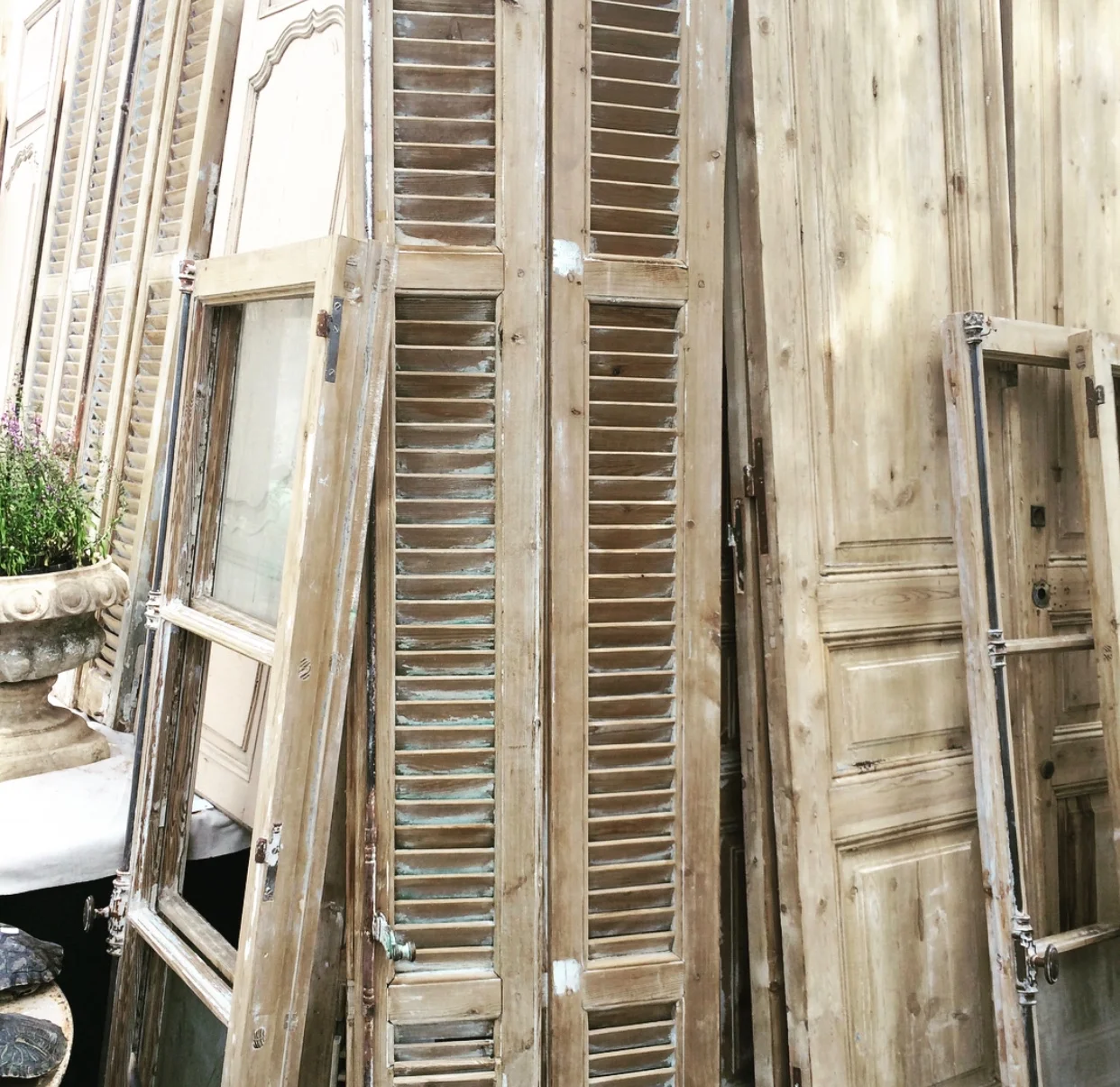While walking through any town or village in France, you will see beautiful shutters. I love the small stone houses with their weathered wood volets in southwestern France. This pair included a sweet kitty who greeted me in the beautiful village of Najac.
"Set wide the shutters. Let me drink in the day.” - Edith Wharton
I took some liberties with the above quote. Edith Wharton said, "windows" but for my story, the meaning is better served with the French word "volets" or shutters. In France, every morning the shutters are opened. Every evening they are closed. Like clockwork, you can tell when the new day begins and when it is time to say goodnight to the world. Everyone goes through this ritual each day. Everyone. Everyday. Volets serve several practical purposes but they also are an effective communication system: "I'm ready to engage with visitors" or "It's time for family and privacy."
You can find wonderful old, oak shutters in various states of repair throughout France. All they need is quite a bit of TLC and they'll be ready to give service for countless more years. J'adore them all!
Volets are not just decorative. They move. They serve a purpose. They are there to be used. They are functional. While it can feel like a task performing this dance each day of opening and closing the shutters, it is expected. You might get away with keeping the upstairs windows closed, but the ones at street level must always perform. It is an unwritten requirement in any French village.
Shutters serve several purposes. First is for insulation. They help keep the heat indoors in the winter and the cool air inside in the summer. Few houses in Europe have air conditioning, so it's important to keep the hot sun out and allow the thick stone walls to cool the home. With the heat waves of this past summer, cooling interiors has become a major concern. Shutters also keep out harsh elements, such as high winds and heavy rains. They serve as protection. At sundown when you draw your shutters, you are telling your community that your home is secure and ready for the night. They offer needed privacy for village life.
You can find these unusual shutters in Provence. They are a type of half shutter that can be partially opened to let fresh air in yet keep the harsh summer sun out.
Shutters in their first form are believed to have originated in Greece. They allowed homes to be sheltered from the hot sun but still permitted a breeze to flow through. Those first shutters were likely constructed with fixed louvers made from marble. Eventually, the concept of shutters for controlling light, ventilation, and the heat from tropical environments spread throughout the Mediterranean and their form began to change. Wood started to replace marble and designers developed movable louvers to allow varying amounts of light into a space.
In medieval Europe, the shutters were hung on the inside of the much smaller windows, rather than on the exterior of the building. They had small holes and were covered with oiled parchment or translucent fabric. They let in a bit of light and kept out the elements. With new building techniques in the 13th century, windows became larger. This time also saw the advent of glass and shutters were shifted into spaces built into the woodwork beside the widows. Not until the mid 18th century did shutters move to the exterior.
In addition to their many purposes, shutters were also used for advertising. This set can be found in the beautiful town of Beaune in Burgundy. They have been left to age gracefully.
One tale holds that the idea of shutters came to France in the 17th century. When Louis XIV moved the French court from the Louvre in Paris to Versailles, it is noted that he enjoyed the country life including admiring the women of his court bathing in the many ponds within the gardens. Rumor holds that the nude women also distracted the guards who were suppose to be on duty protecting the palace. King Louis had movable louvered shutters installed around his garden walls so that he could open them and gaze at the women, but the guards could not see in.
This colorful slatted style of shutter is found in towns along the French Rivera. Here in Villefranche, you can enjoy the village's volets and their pastel color palette. As the day heats up, the shutters close, keeping precious cool air inside.
It wouldn't be a house in France without shutters. While some see it as a chore, I see opening them in the morning as a way to "drink in the day." Closing them in the evening allows me to shift gears and focus my attention inwards toward family. French culture embraces the process of daily tasks. This might run contrary to my American sentiments of the value of efficiency. Yet, as I incorporate new ways of doing things into my everyday life, I like the idea of focusing on why something is done, rather than on the time it takes to complete the task.
If your home lacks movable shutters, no worries. Create your own daily ritual. Open the blinds or curtains and take the moment to be grateful for the new day. Close them at night and remind your mind and body that it is time to rest.
I think it's a valuable French habit to cultivate.
À bientôt,
Karen
I add a blog post quarterly to Karen’s Atelier - more or less with the changing seasons. For a weekly dose of something "short and sweet" and a nod to French culture, be sure to subscribe to my Weekly Voilàs on this website. For those that have already subscribed, merci. Your support encourages me to take the next step in “living a french life.” It is a privilege to share this journey with you.





